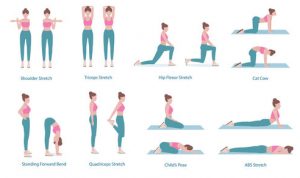
The Vacci-Con Job
June 30, 2021
Know the Basics…part 2
July 6, 2021- 40 plus training
- beginners guide to the gym
- beginners warmup
- dynamic warmup
- exercise chart
- exercise log
- fitness
- full body warmup
- gym
- gym tips
- health and safety
- how to begin a training session
- how to start a gym session
- how to stretch
- how to warmup
- how to warmup for beginners
- individual muscle warmup
- muscle building
- range of motion
- risks of stretching
- static warmup
- stretching
- warmup
- weight training
- weight training chart
Warmup and Stretching Effectively.
Allow Ayl’s40Fit to start this topic off in a very unconventional manner.
A warmup, stretching, and cool-down routine is the accepted standard although not the most commonly followed standard in most gyms. It should be, however, it should be with certain considerations in mind.
In countries where the ambient temperature is 10 degrees Celsius, a warmup is crucial to prevent injury to muscles and tendons. A muscle or a tendon tear can take months to heal, there is no guarantee that it would be 100%, not allowing one to lift the same kind of weights as before the injury.

Consider a country like India, wherein cities like Mumbai, temperatures can reach the early 40 Degree Celsius with humidity of 80-85%. I have observed personal coaches in the gym do the following:
- Get a trainee to do 15 minutes on a treadmill to warm up when he/she has walked/ cycled to the gym. In 35 degrees Celsius heat.
- Get a trainee to do skipping or stationary cycling for 15 minutes when the trainee’s training time is 8 pm. This means, the said trainee has done a full day’s work and then comes to the gym. All done in 35 degrees Celsius heat.
Done when the trainee has entered a gym atmosphere cooled down to 21 Degrees Celsius from the sweltering 35-40 Degrees outside. This in itself is detrimental to health in the long run, read as arthritis and joint issues even the onset of pneumonia.
People here believe that since they are paying, all facilities should be used to the maximum, all except the gym equipment.
This is ridiculous and is not what a warmup is supposed to be but is followed by all parrot-trained coaches in most gyms. I have seen such trainees exhausted before starting the day’s routine and quitting within the first 3 months, either from the stress of the so-called exercise or recurring illness due to the ambient temperature.
In such situations, it would have been a better idea to get the trainees to do Range of Motion exercises and be limber for the coming workout since their bodies were already sufficiently warmed up with the entire day’s activities in the sweltering heat.
Most websites miss this point:
Keep in mind, I am not against AC usage in a gym. Just against it being used incorrectly. Most websites on the internet only talk about AC or No AC choices.
My point is this: In our overheated environment it is good to work out in comfort. However, comfort and “Paisa Vasool”, i.e. “Getting the most for your coin” are two different things.
The air condition temperature set in a gym environment should be a few degrees lower than the outside. In other words, the difference between the environment temperature and the gym atmosphere should be as minimal as possible.
Outside temp= 38-40 degrees C and Gym temp= 20 degrees C is not advisable.
If you walk into a gym and feel the cold tingle with your first inhaled breath, it’s too cold and unnatural.
If you walk into a gym and feel comfortable or pleasant without a noticeable chill, it’s ideal.
Why exercising with air conditioning on is a very bad Idea?
Should you turn the AC on while working out?
With that out of the way,
Let’s get to the warmup…

Only you will know how warmed up your body is when you enter the Gym. It depends on which part of the day you reserve to exercise. If your routine involves a workout first thing in the morning, spend more time warming up. After a night’s sleep, all the muscles and tendons of the body are loose and relaxed. They need to be activated or the risk of injury by directly getting into the main exercise regimen is high.
If your Gym slot is at the end of an entire work day and travel home, the body has already been active for hours and the focus here would be more on the range of motion warmups.
For an early morning workout:
Start with either a five to six-minute brisk walk (i.e. arms bent 90 degrees at the elbow, kept by your sides and moving simultaneously with opposite legs) or jog on the treadmill, alternatively a medium pace on the stationary bike or elliptical machine. This should wake up your entire body and inform it that more is to come. Do not depend on sweat as an indicator of being warmed up, as in todays extra cold gyms it would take one longer to sweat. By the time you do, it’s way past the warmup.
For a workout later on in the day:
The body is relatively warmed up already.
Personally, a warm up at this time of day is taken care of by doing abdominals. Slow repetitions emphasizing the contractions in the abdominals, not the fast-paced bouncy repetitions some people do. I have found it to be very advantageous to go through abdominals before weight training as the core is tight and the connection between your upper and lower body is strong and ready to support each other. This is especially true on Shoulder and Leg training days.
Alternatively,
One could do a full range of motion warmups for joint flexibility as although the body may be warmed up the joints and sockets in the body may be relatively unused throughout the day. For instance, if one has a desk job.
a 2014 study published in The Journal of Strength and Conditioning Research found that static stretching before exercise may limit performance when participating in strength training or other forms of exercise that require explosive power, such as sprinting or jumping. This makes a pre-workout static stretch less than ideal for many populations, especially athletes and individuals focused on power-based training.
Range of Motion Exercises: Wrists, Elbows, Forearms, and Shoulders. PDF
Lower Body: Passive Range of Motion Exercises. PDF

After completion of the applicable warmups described above, supplement it with bodyweight exercises to get the joints, muscles, and tendons ready for some serious weights.
Pushups: 2-3 sets of 15 reps.
Lunges: 2-3 sets of 15 reps.
Pullups: 2-3 sets of 15 reps
Abdominals (if not done): 2-3 sets 20 reps of sit-ups or crunches, and
2-3 sets 20 reps of leg raises.
And we are done.
By now you should be thoroughly warmed up with flexible joints/ tendons and a tight core.
The entire warmup routine should be approximately 15-20 minutes.
Exercise specific warmup:
This is also a very effective kind of warmup that I follow most of the time if I am exercising in the latter half of the day.
After ROM exercises to mobilize the joints and abdominal exercises to tighten the core, I go straight into my exercises for the day.
Let me give you an example with the bench press.
Start with a weight with which you can do between 20-25 reps easily. By that I mean the last repetition should not be with the grinding of the teeth like with a normal set. Do two sets of these, slowly and with attention to the range of motion of the exercise, without bouncing the bar off the chest or locking the elbows at the top of the movement.
You will feel the burn after the two sets. Do a set or two of chest stretches (check diagram) to loosen things up and get into your normal pyramid sets for the bench press.
I prefer this type of warming up as it is done along with the exercise I need to do for the day and matches its movement.
For Example: Why tax the legs by doing cycling or a treadmill mile on chest/ back day, in order to warm up, when I have a grueling leg day coming up tomorrow.
Cooling Down and Stretching:
Many gym enthusiasts follow a kind of warmup routine to cool down as well. Like a five-minute slow walk on the tread.
I have never seen the point of this.
 After a hard day lifting metal, the muscles are fully pumped with blood and lactic acid. They are a bit stiff and restricted in their movement.
After a hard day lifting metal, the muscles are fully pumped with blood and lactic acid. They are a bit stiff and restricted in their movement.
Lactic acid is produced in your muscles and builds up during intense exercise. It can lead to painful, sore muscles. Lactic acid buildup due to exercise is usually temporary and not cause for a lot of concern, but it can affect your workouts by causing discomfort.
Instead of performing stretching exercises as a warmup regimen, it would be advisable to stretch the muscles after an intense workout in the gym. This would relax them, reduce fatigue and pain, improve blood circulation and lessen the effect of the accumulated lactic acid.
A very important point here is to maintain a deep, slow and focused breathing pace while performing stretching to cool-down. This will lower your heart rate and relax the body, in essence the objective of performing a cool-down routine.
What Kind Of Stretching Should I do?
According to how stretching is performed, there are two main types. Of course, variations of these are aplenty but these are the fundamental concepts.
Ballistic Stretching:
Ballistic stretching uses the momentum of a moving body or a limb in an attempt to force it beyond its normal range of motion.
This is done by bouncing into (or out of) a stretched position, using the stretched muscles as a spring which pulls you out of the stretched position. (e.g. bouncing down repeatedly to touch your toes.)
Ballistic stretches involve trying to force a part of the body beyond its range of motion.
This type of stretching is not considered useful and can lead to injury.
It does not allow your muscles to adjust to, and relax in, the stretched position. It may instead cause them to tighten up by repeatedly activating the stretch reflex .
Which leaves us with…
Dynamic Stretching:
Dynamic stretching involves moving parts of your body and gradually increasing reach, speed of movement, or both.
It consists of controlled leg and arm swings that take you, gently, to the limits of your range of motion. In dynamic stretches, there are no bounces or “jerky” movements.
An example of dynamic stretching would be slow, controlled leg swings, arm swings, or torso twists.
These stretching exercises should be performed in sets of 8-12 repetitions. Be sure to stop when and if you feel tired. Tired muscles have less elasticity which decreases the range of motion used in your movements.
Once you attain a maximal range of motion for a joint in any direction you should stop doing that movement during that workout.
{Anyone who has gone through a hard leg day in the gym knows the kind of immobility and tightness in the legs which can restrict normal walking ( read that as forced to walk like a duck) post-workout. This can take 15-20 minutes to reduce if one sits around and 5-10 minutes if light stretching is done as a cool-down.}
The links below contain short videos demonstrating Stretching and Cool-down methods.


Stretching and Warmups for Weight Training.
14 Best Cool Down Exercises to Recover and Stretch After a Workout




